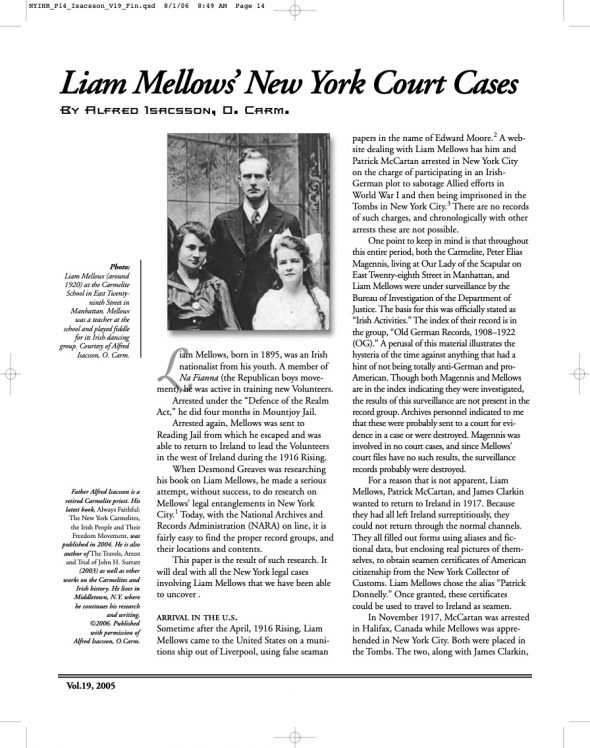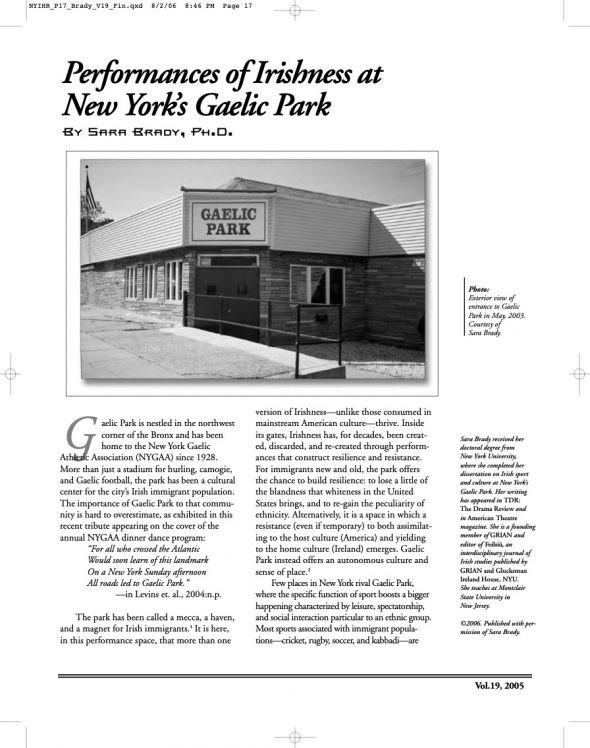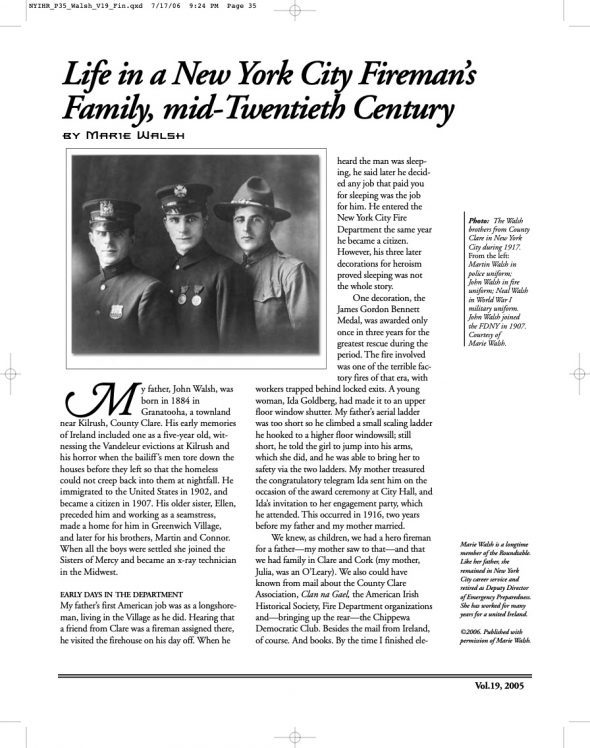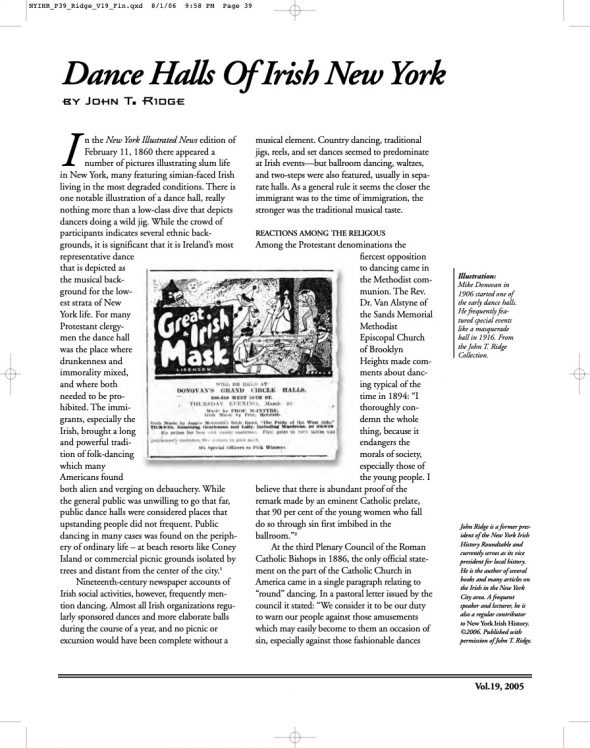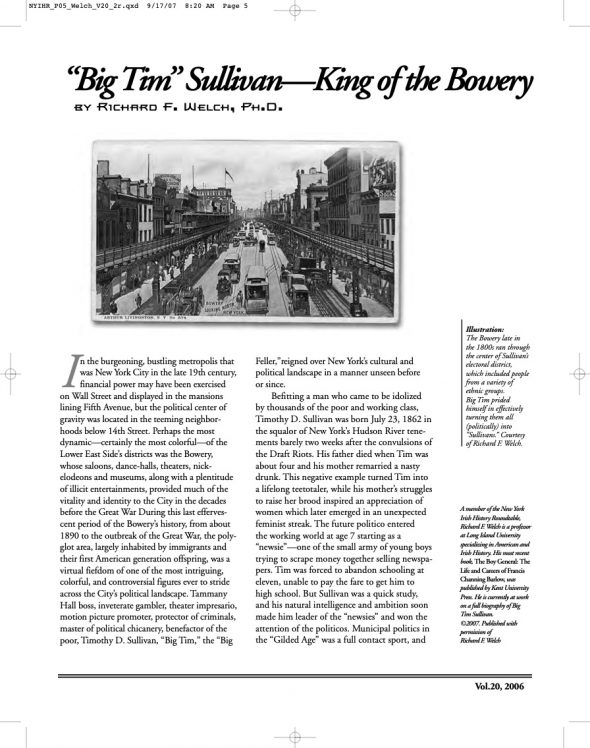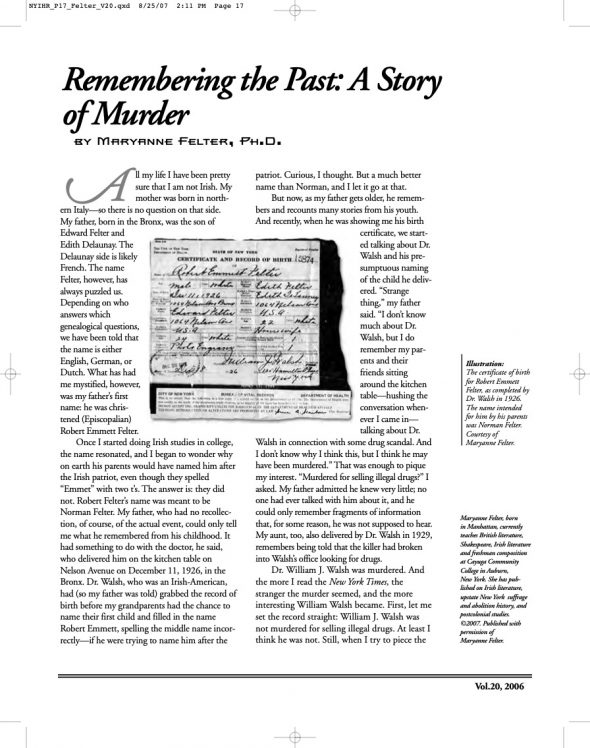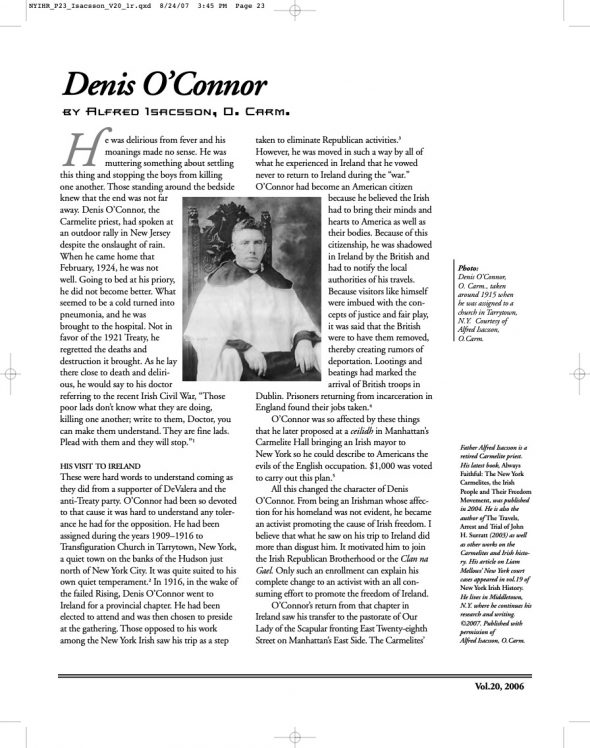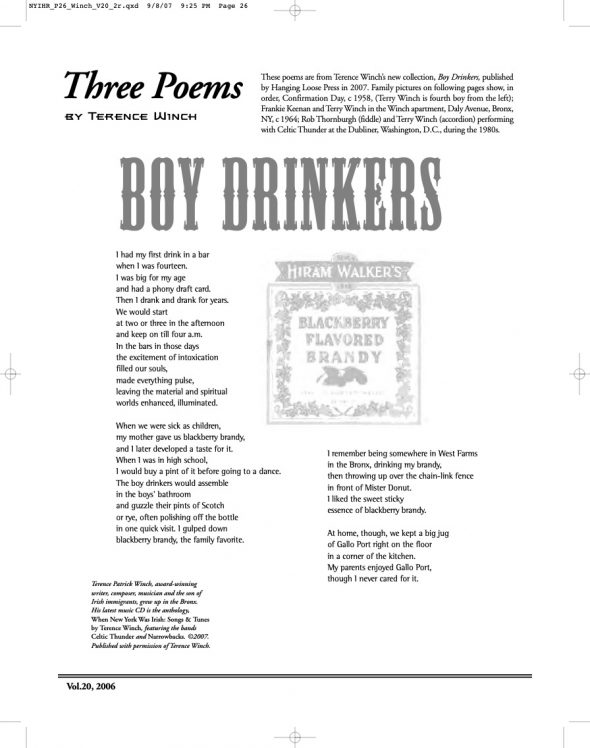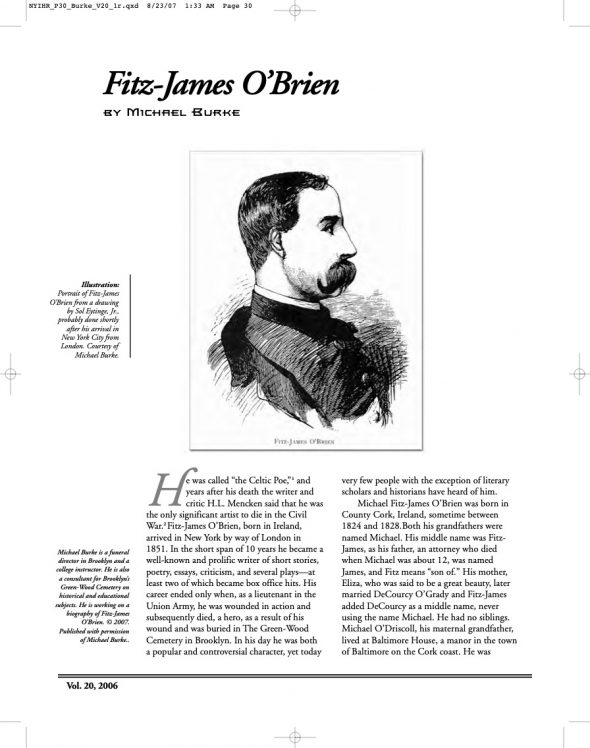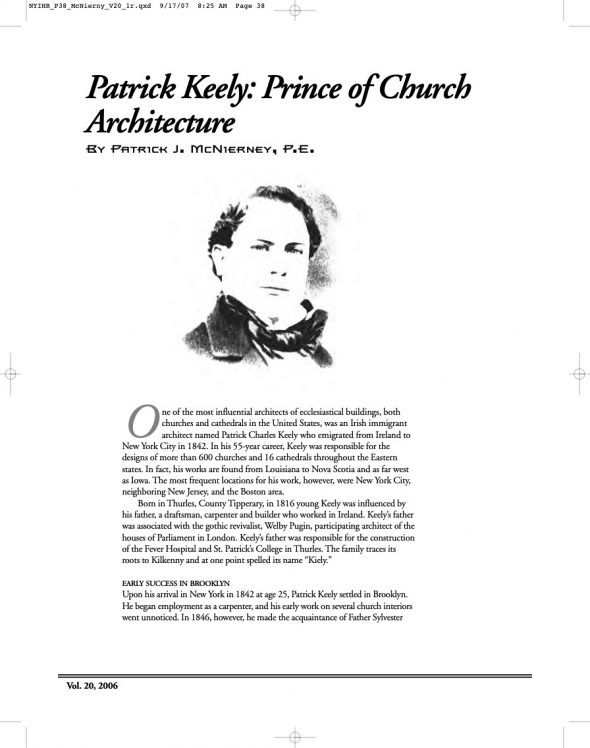New York Irish History Roundtable - Journal Articles
Liam Mellows’ New York Court Cases
Author: Alfred Isacsson, O. Carm.
Publication Year: 2005
Journal Volume: 19
Article Reference: NYIHR-V19-02
Liam Mellows, born in 1895, was an Irish nationalist from his youth. A member of Na Fianna (the Republican boys movement), he was active in training new Volunteers.
Arrested under the "Defence of the Realm Act," he did four months in Mountjoy Jail.
Arrested again, Mellows was sent to Reading Jail from which he escaped and was able to return to Ireland to lead the Volunteers in the west of Ireland during the 1916 Rising.
When Desmond Greaves was researching his book on Liam Mellows, he made a serious attempt,... [Read Full Article]
Performances of Irishness at New York’s Gaelic Park
Author: Sara Brady
Publication Year: 2005
Journal Volume: 19
Article Reference: NYIHR-V19-03
Gaelic Park is nestled in the northwest corner of the Bronx and has been home to the New York Gaelic Athletic Association (NYGAA) since 1928. More than just a stadium for hurling, camogie, and Gaelic football, the park has been a cultural center for the city's Irish immigrant population.
The importance of Gaelic Park to that community is hard to overestimate, as exhibited in this recent tribute appearing on the cover of the annual NYGAA dinner dance program: "For all who crossed the Atlantic Would soon learn of this landmark... [Read Full Article]
Life in a New York City Fireman’s Family, mid-Twentieth Century
Author: Marie Walsh
Publication Year: 2005
Journal Volume: 19
Article Reference: NYIHR-V19-04
My father, John Walsh, was born in 1884 in Granatooha, a townland near Kilrush, County Clare. His early memories of Ireland included one as a five-year old, witnessing the Vandeleur evictions at Kilrush and his horror when the bailiff's men tore down the houses before they left so that the homeless could not creep back into them at nightfall. He immigrated to the United States in 1902, and became a citizen in 1907. His older sister, Ellen, preceded him and working as a seamstress, made a home for him in Greenwich Village, and later for... [Read Full Article]
Dance Halls of Irish New York
Author: John T. Ridge
Publication Year: 2005
Journal Volume: 19
Article Reference: NYIHR-V19-05
In the New York Illustrated News edition of February 11, 1860 there appeared a number of pictures illustrating slum life in New York, many featuring simian-faced Irish living in the most degraded conditions. There is one notable illustration of a dance hall, really nothing more than a low-class dive that depicts dancers doing a wild jig. While the crowd of participants indicates several ethnic backgrounds, it is significant that it is Ireland's most representative dance that is depicted as the musical background for the lowest strata... [Read Full Article]
Big Tim Sullivan—King of the Bowery
Author: Richard F. Welch, Ph.D.
Publication Year: 2006
Journal Volume: 20
Article Reference: NYIHR-V20-01
In the burgeoning, bustling metropolis that was New York City in the late 19th century, financial power may have been exercised on Wall Street and displayed in the mansions lining Fifth Avenue, but the political center of gravity was located in the teeming neighborhoods below 14th Street. Perhaps the most dynamic - certainly the most colorful - of the Lower East Side's districts was the Bowery, whose saloons, dance-halls, theaters, nickelodeons and museums, along with a plentitude of illicit entertainments, provided much of the vitality... [Read Full Article]
Remembering the Past - A Story of Murder
Author: Maryanne Felter, Ph.D.
Publication Year: 2006
Journal Volume: 20
Article Reference: NYIHR-V20-02
All my life I have been pretty sure that I am not Irish. My mother was born in northern Italy - so there is no question on that side. My father, born in the Bronx, was the son of Edward Felter and Edith Delaunay. The Delaunay side is likely French. The name Felter, however, has always puzzled us.
Depending on who answers which genealogical questions, we have been told that the name is either English, German, or Dutch. What has had me mystified, however, was my father's first name: he was christened (Episcopalian) Robert Emmett... [Read Full Article]
Denis O’Connor
Author: Alfred Isacsson. O. Carm.
Publication Year: 2006
Journal Volume: 20
Article Reference: NYIHR-V20-03
He was delirious from fever and his moanings made no sense. He was muttering something about settling this thing and stopping the boys from killing one another. Those standing around the bedside knew that the end was not far away. Denis O'Connor, the Carmelite priest, had spoken at an outdoor rally in New Jersey despite the onslaught of rain.
When he came home that February, 1924, he was not well. Going to bed at his priory, he did not become better. What seemed to be a cold turned into pneumonia, and he was brought to the... [Read Full Article]
Three Poems by Terence Winch
Author: Terence Winch
Publication Year: 2006
Journal Volume: 20
Article Reference: NYIHR-V20-04
I had my first drink in a bar when I was fourteen. I was big for my age and had a phony draft card. Then I drank and drank for years. We would start at two or three in the afternoon and keep on till four a.m. In the bars in those days the excitement of intoxication filled our souls, made everything pulse, leaving the material and spiritual worlds enhanced, illuminated.
When we were sick as children, my mother gave us blackberry brandy, and I later developed a taste for it. When I was in high school, I would buy a... [Read Full Article]
Fitz-James O’Brien
Author: Michael Burke
Publication Year: 2006
Journal Volume: 20
Article Reference: NYIHR-V20-05
He was called "the Celtic Poe," 1 and years after his death the writer and critic H.L. Mencken said that he was the only significant artist to die in the Civil War. 2 Fitz-James O'Brien, born in Ireland, arrived in New York by way of London in 1851. In the short span of 10 years he became a well-known and prolific writer of short stories, poetry, essays, criticism, and several plays - at least two of which became box office hits. His career ended only when, as a lieutenant in the Union Army, he was wounded in action and... [Read Full Article]
Patrick Keely - Prince of Church Architecture
Author: Patrick J. McNierney, P.E.
Publication Year: 2006
Journal Volume: 20
Article Reference: NYIHR-V20-06
One of the most influential architects of ecclesiastical buildings, both churches and cathedrals in the United States, was an Irish immigrant architect named Patrick Charles Keely who emigrated from Ireland to New York City in 1842. In his 55-year career, Keely was responsible for the designs of more than 600 churches and 16 cathedrals throughout the Eastern states. In fact, his works are found from Louisiana to Nova Scotia and as far west as Iowa. The most frequent locations for his work, however, were New York City, neighboring New... [Read Full Article]

